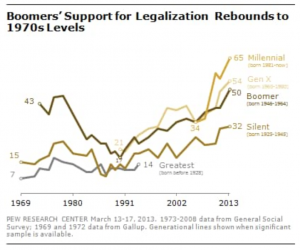Smoking weed is often seen as an indulgence reserved for the young and the reckless: kids get high, in the popular imagination, but by and large their parents don’t.
But new federal data show a stunning reversal of that age-old stereotype. Middle-aged Americans are now slightly more likely to use marijuana than their teenage children.
The research, released this week by the Centers for Disease Control and Prevention, found that only 7.4 percent of Americans aged 12 to 17 years old smoked marijuana regularly in 2014, a 10 percent decline since 2002. But 8 percent of 35 to 44 year olds used marijuana regularly in 2014, surpassing use among teens for the first time since at least 2002. (Survey data prior to that year aren’t directly comparable, as the methodology changed.)
And it’s not just middle-aged folks who are indulging more often. Since 2002, regular marijuana use among Americans age 45 to 54 has jumped by nearly 50 percent. Among those ages 55 to 64, it’s jumped by a whopping 455 percent (no, that’s not a typo).
And among seniors, age 65+, monthly marijuana use is up 333 percent since 2002.

Graph Credit: The Washington Psot
“During the last 13 years, marijuana use (i.e., past-month marijuana use) has steadily increased in the United States, particularly among people aged 26 years or older,” said report author Alejandro Azofeifa in an email. “Older groups had a significant increase of marijuana use in the past month.”
To put it another way: If trends continue like this, marijuana use among 50- and even 60-somethings could be higher than use among teens in a few years.
Much of the debate around marijuana legalization focuses on the drug’s potentially negative effects on teens: “what about the children?” as the common refrain goes. This makes a certain amount of sense, since the still-developing minds of adolescents and young adults are most susceptible to the potential long-term harms of heavy marijuana use. But the federal survey numbers on marijuana use suggest that voters considering whether to legalize pot should be asking themselves a different question: “what about grandpa?”
There are several factors that could explain rising marijuana use rates among the middle-age-and-up crowd. The first is the growing prevalence of medical marijuana, which is now allowed in 25 states and D.C. Older Americans are increasingly turning to medical pot to treat some of the common ailments of old age, like sleeplessness, aches and arthritis pain (here’s looking at you, Rep. Dana Rohrabacher (R.-Ca.)).
Research shows, for instance, that Medicare prescriptions for a number of common drug types — painkillers chief among them — are falling in states that allow medical marijuana. This suggests that a significant number of seniors in those states are opting for pot over more traditional medications.
Another explanation: Aging Boomers seem to be taking advantage of loosening restrictions on marijuana use — particularly in states where the drug is fully legalized — to relive some of the recreational indulgences of their youth.
National survey data bears this out: the Boomer generation were big supporters of legalization in the 1970s. But as they got jobs, had kids and settled down in the 1980s, their support for legalization plummeted. It began to rebound in the 1990s, and as of 2013, half of Boomers supported legalization.

Graph credit: The Washington Post
The marijuana industry is taking note of these shifts, and in places like Colorado and Washington companies are actively marketing toward aging Boomers looking to give weed another chance. Roughly one quarter of marijuana purchasers in Washington state, for instance, are over the age of 40.
So while supporters and opponents of marijuana legalization in California and elsewhere tussle over the impacts of legalization on children, these numbers suggest that legalization would bring the biggest changes to the lives of kids’ parents — and their grandparents, too.
(1208)





Leave A Reply